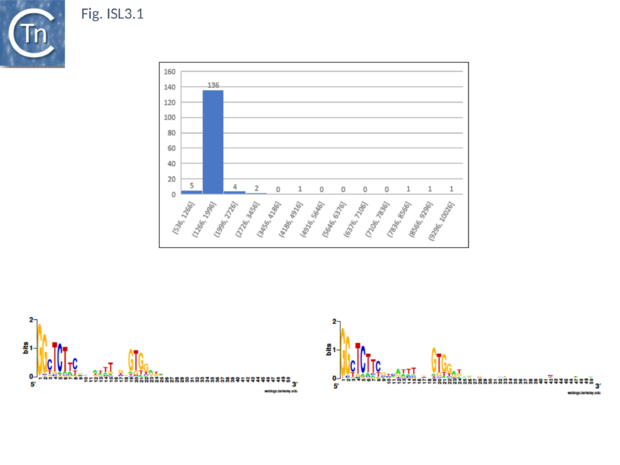IS Families/ISL3 family
Original Identification
The founding member ISLr2 was identified in Lactobacillus delbrueckii subsp. Bulgaricus[1] a bacterium used mainly for production of yogurt in mixed-strain thermophilic culture together with Streptococcus thermophilus where is being responsible for the loss of the capacity to ferment lactose. It was noted to be similar to IS1165 from Leuconostoc mesenteroides subsp. cremoris strain DB1165 also used in commercial mesophyllic starter cultures[2].
Distribution
There are more than 150 members from nearly 80 bacterial species. The family also includes archaeal members, particularly in the Methanomicrobia.
Potential tIS derivatives with passenger genes appear quite common. These include a mercury resistance operon[3] in Tnmer1 (AY351675) from a conjugative plasmid, pPPM1000, in Enterococcus faecium and in ISStma11 from Stenotrophomonas maltophilia (NC_010943). A number of other tIS derivatives with additional types of passenger gene such as restriction modification systems in Acinetobacter bereziniae (ISAbe14; LKDJ01000006), Seratia marcesens (ISSm1) Klebsiella pneumoniae (ISKpn25; NC_009650) have also been identified. There are several additional examples of this type of structure: ISPpu12 (Pseudomonas putida; AY128707); ISPst2 (Pseudomonas stutzeri ; AJ012352); ISEc53 (Escherichia coli; HG941718); ISRso21 (Ralstonia solanacearam).
IS1167 copies have been found flanking the cap1 (capsular polysaccharide) locus of type 1 S. pneumoniae forming a potential compound transposon[4]. It has also used as a tool to distinguish between S. pneumoniae strains[5] using IS1167 Restriction Fragment Length Polymorphism (RFLP) pattern analysis[6]. The Pseudomonas putida, IS1411, was discovered by its ability to insertional activate promoter less pheBA genes by insertion due to an outward-directed promoter(s) at its left end[7].
Small sequences (130-340 bp) related to the IS1167 IRs have been detected in Streptococcus sanguis, S. pneumoniae, and S. agalactiae[8][9].
Organization
Members range in size from 1186 bp to 1553 bp, carry closely related IR of between 15 and 39 bp (Fig.ISL3) and generate DR of 8 bp. They generally have a single orf of between 400 and 440 amino acids which shows good alignment and includes an α-helical insertion domain[10].

While most carry only a single orf, the transposase, several variants include additional orfs: IS1096 harbors two orfs: the upstream orf exhibits similarities to the ISL3 family Tpases; the second, tnpR, a MerR-like transcription factor, is related to orfs from Agrobacterium rhizogenes and Rhizobium sp. plasmids. TnpR appears to regulate transposition activity of ISPpu12[11]; ISPpu12 in addition to a tnpA homologue carries three open reading frames, a PnbR-like regulatory protein of the MerR family, a putative membrane/transport protein and a putative lipoprotein signal peptide-like protein (lspA)[12][13].
In IS1167, the reading frame appears to be distributed between two consecutive orfs with a potential for translational coupling suggested by overlapping initiation and termination codons (ATGA).
Mechanism
Transposition of most of these elements has been demonstrated, but no detailed analysis of their transposition mechanism has yet appeared. IS1411 from Pseudomonas putida forms a circular species with abutted IS ends separated by 5 bp from the DNA flank of one IS end [7]. Clearly, as is the case in other IS which form circular transposition intermediates, expression of the tnp gene will be driven by the leftward oriented promoter. Transposon circles are also formed by ISPst9[14] and the tIS, Tnmer1 [3] and in both cases the abutted IRs are also separated by 5 bp. An isoform of ISPpu12[11], IS31831 and IS1411[7] forms DNA species with a size expected for an excised transposon circles. For IS31831, derivatives of which have been used in mutagenesis, the majority of insertions were found to be simple and only rare clones carried accompanying vector DNA[15].
There is some evidence indicating that transposition of these IS can be induced by a form of zygotic induction following conjugative transfer [11] although the phenomenon is not understood. ISPst9 undergoes transposition in the resident Pseudomonas stutzeri strain when brought into contact with a conjugative E. coli strain, E. coli S17-1 lambda(pir), and undergoes deletion. Activation requires a second ISL3 derivative, ISPpu12, in the same strain.
Although both ISL3-like ISs are similar, they differ in their accompanying genes: Mutation of TnpR, a MerR-like transcriptional regulator present in ISPpu12 but not in ISPst9, reduced the ISPpu12 tnpA transcription and decreased formation of transposon circle transposition intermediates after conjugative interaction. Complementation of TnpR restored the ability to activate transposition but the expression of TnpR in the absence of ISPpu12 did not result in conjugative induction of ISPst9. This suggests that ISPpu12 TnpR activates ISPpu12 tnpA transcription and raises the possibility that ISPpu12 TnpA might bind IRs of both ISPpu12 and ISPst9 and catalyze transposition of both elements.
No obvious target sequence specificity has yet been observed, although there is some suggestion that there may be a preference for AT-rich regions.
Bibliography
- ↑ <pubmed>7565604</pubmed>
- ↑ <pubmed>1325060</pubmed>
- ↑ 3.0 3.1 </nowiki>
- ↑ <pubmed>11902728</pubmed>
- ↑ <pubmed>9878026</pubmed>
- ↑ <pubmed>10747146</pubmed>
- ↑ 7.0 7.1 7.2 Kallastu A, Hõrak R, Kivisaar M . Identification and characterization of IS1411, a new insertion sequence which causes transcriptional activation of the phenol degradation genes in Pseudomonas putida. - J Bacteriol: 1998 Oct, 180(20);5306-12 [PubMed:9765560] [DOI] </nowiki>
- ↑ <pubmed>2352474</pubmed>
- ↑ <pubmed>7597107</pubmed>
- ↑ <pubmed>20067338</pubmed>
- ↑ 11.0 11.1 11.2 </nowiki>
- ↑ <pubmed>12426346</pubmed>
- ↑ <pubmed>12426347</pubmed>
- ↑ <pubmed>18645960</pubmed>
- ↑ <pubmed>8196545</pubmed>